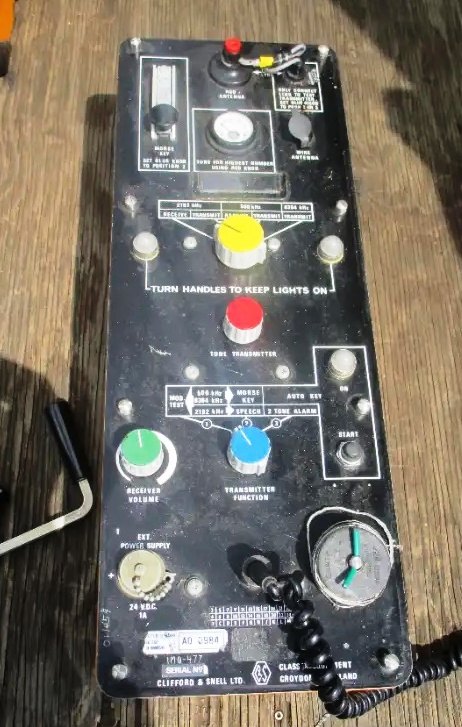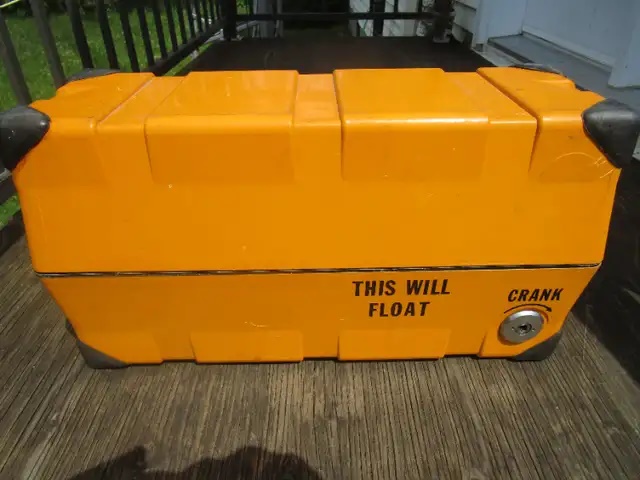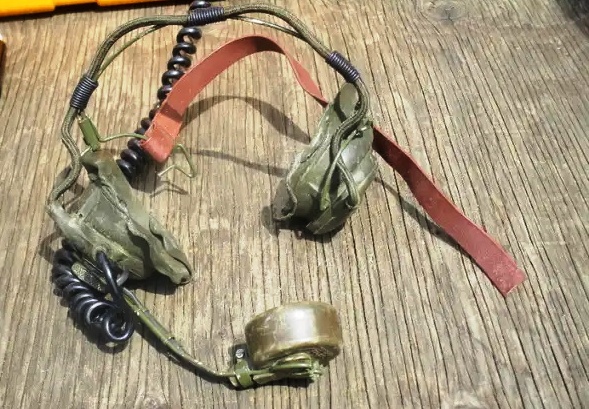 |
| Survivor II lifeboat transmitter/receiver. . (Photo courtesy Radio Officers.com web page) |
Frequency Range: 500 or 2182 or 8364 KHz. using three crystal controlled frequencies. .Modes: MCW (A2) on 500; A3 mode on 2182 and 8364 kHz.
Technology: Solid state transmitter except for two valves; solid state receiver.
Operation: Transmits on 500, 2182 and 8364 KHz . Receives on 500 and 2182 KHz. Automatic keying facilities are included to transmit the twelve, 4 second dash alarm signal plus SOS. Hand keying is also provided and a boom microphone is fitted to the headset for speech transmission.
Power output: Between 2 and 5 watts.Using rod antenna
500 KHz - 2.4 watts
2182 KHz 2.5 watts
8l64 KHz - 4 wattsUsing wire aerial:
500 kHz - 2.6 watts
2182 KHz 3 watts
8l64 KHz - 4 wattsWeight: 35 lbs.
Dimensions: 21" x 8" x 10".
Designators: Made by Clifford & Snell as type 710 for Marconi Marine. Rebranded as "Survivor" by Marconi.
Known variants: Survivor III.Comment: A steel, telescopic aerial extends from 20 inches to over 15 feet. Two handles for operating the internal generator are also stored in the cover along with full instructions for use. There is also provision for an external power source of 24 to 30V DC. A built-in key has been provided in the upper left corner of the unit. however to operate the key and crank the internal generator would require a three armed operator.
COMMENTARY
So which of the three distress frequencies would be used by someone in a lifeboat? Sandy Blaize W5TVW explains. " It depends on where you are. If you are close to rescue stations (Coast Guard, L.S.S. or whatever.) use 2182, then 500 KHz. then 8364 KHz. 2182 usually has shortest range and is voice only. Some sets broadcast a two tone distress signal which rings bridge bells if received. 500 KHz is the best short to medium haul for CW communications. It generates an auto alarm dash sequence along with an SOS and you can also communicate via W/T to any answering ship or station. 8364 KHz was best best for long haul SOS call. The SOS sequence would be generated but CW two way (W/T) communication was not possible. No auto alarm equipment was normally carried for use on 8364 KHz ( the the best of my knowledge) only on 500 KHz.
Not all lifeboat sets operated on 2182 KHz., just 500 and 8364 KHz. Most newer ones operated on all three. The old “Gibson Girl” which had no receiver, just a transmitter, only operated on the 8364 (8080? in earlier sets) and 500 KHz only. These were the ones carried on military aircraft in case of a forced landing at sea for a rescue aid".
 |
| Survivor II lifeboat transmitter/receiver. . (Photo courtesy Radio Officers.com web page) |
 |
| It appears that this survival radio was made for Marconi Marine by Clifford and Shell and its model designator is 710. |
 |
| Model 710 case markings |
 |
| Model 710 case markings Note the model tag of "Survivor II" and the Marconi Marine logo at the left side . |
 |
| Model 710 - Headphones and microphone. |
| All model 710 photos in this table via-E-bay |
Contributors and Credits:1) http://www.radioofficers.com/galleries/fort-perch-museum/attachment/fpr-survivor/
2) http://www.worthpoint.com/worthopedia/marconi-marine-portable-ships-242383017
3) http://draaggolf.blogspot.ca/2011/09/new-item-in-marine-radio-collection.html
4) Ross Bradshaw [ross.bradshaw@mypostoffice.co.uk]
Sept 11/23